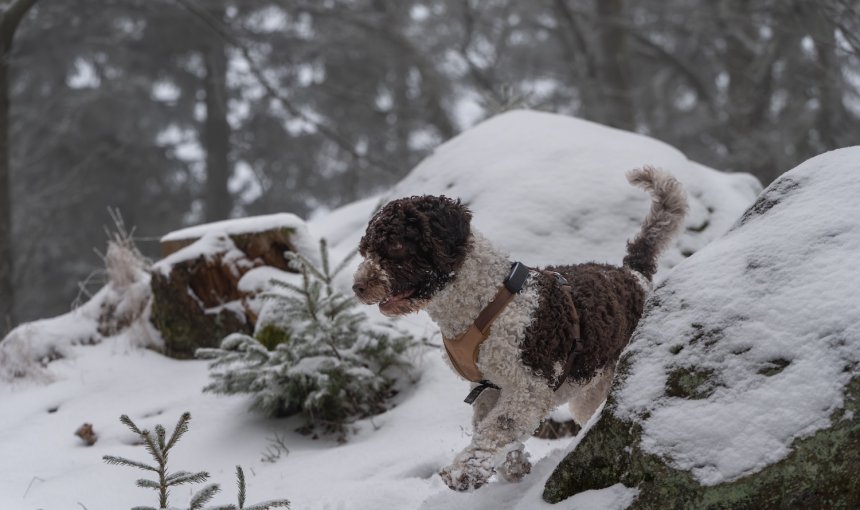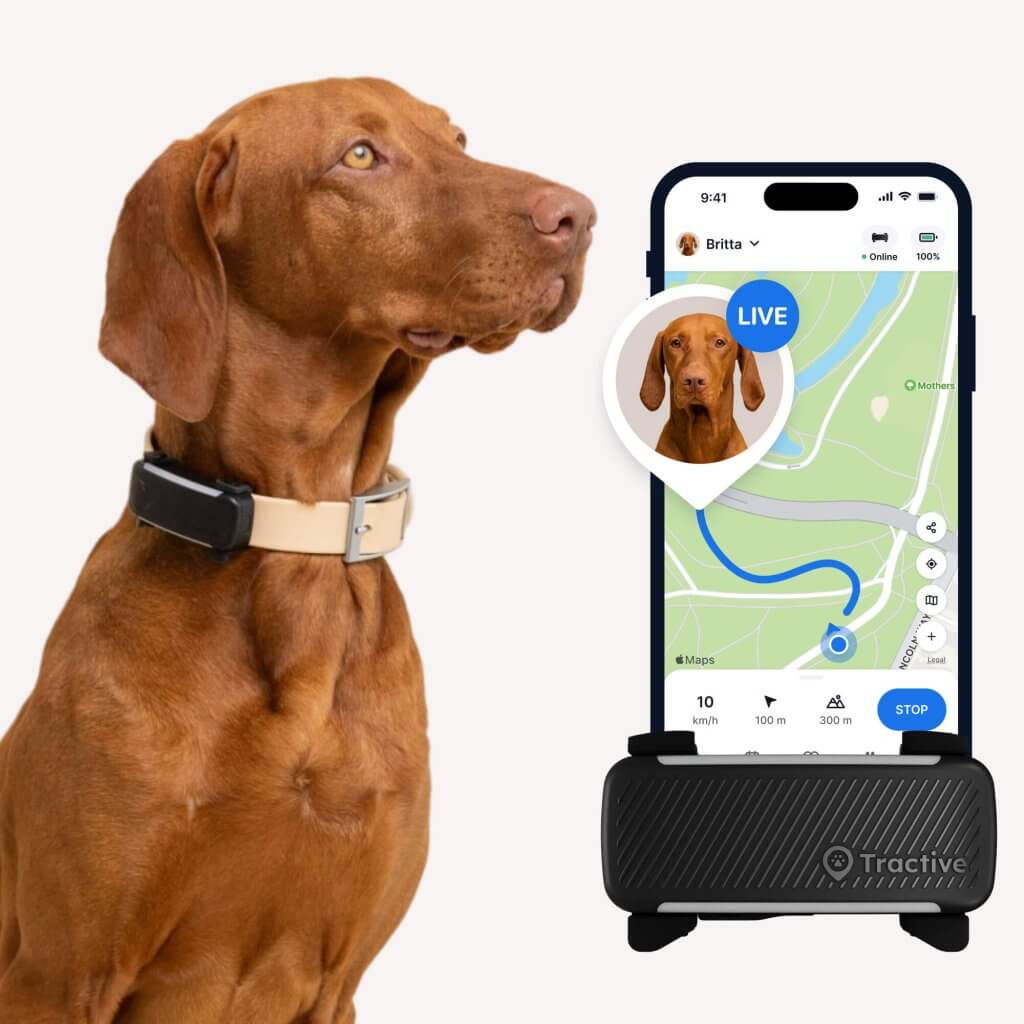Winter Dog Care: Protect Your Dog This Winter With These 8 Tips
Dogs need a little extra love and care in the winter months (as they do all year round). In this post, we'll cover the most important things you need to know about how to keep your dog healthy and safe in winter.

Winter is here! Whether you enjoy it or not – there are special precautions that you’ll need to take in the cold winter months to protect and keep your furry friend safe. Dogs are susceptible to several cold weather dangers, from chapped paws and dry itchy skin, to toxic injury from ice-melting chemicals and even freezing. So whether you are curled up indoors most of the time, or busy enjoying your favorite dog-friendly winter activities, follow these expert winter dog care tips to keep your dog healthy and safe this winter.
Plus: Discover the world’s best waterproof GPS tracker for dogs.

Always know your buddy is healthy & safe
Read moreHow to care for dogs in winter
1. Keep your dog warm
Obviously when it comes to winter safety for dogs, one of the most important factors is keeping your dog warm when temperatures drop. Because depending on where you live, it might get too cold for dogs. Old, young, and small dog breeds are especially vulnerable to the cold, whereas some dogs are better at enduring outdoor conditions.
To keep your dog warm in winter, there are several things you can do:
- Limit your dog’s time outdoors – and keep walks short
- Keep your dog inside when possible – and provide stimulating indoor activity
- Get your dog an appropriate winter wardrobe – from winter dog jackets to booties
- Don’t let your dog sleep on a cold floor – choose warm bedding and place the bed away from drafts, cold tile or uncarpeted floors. Or consider using a heated dog bed – if you’re not already letting your dog sleep in your bed
- Make sure your furry friend gets plenty of movement & exercise
- Keep your dog dry – use a towel to dry them off after going outdoors
- Never trim your dog’s coat down to the skin in winter time – their furry coat is essential for keeping them warm

Keep track of your dog’s daily adventures
Follow every step with unlimited range Live Tracking. Get alerts if they wander too far. Keep them happy & healthy with Activity & Sleep Monitoring. Get Health Alerts if something seems off.
Never leave your dog in the car unattended: Just as cars can get dangerously hot in summer, freezing cold temperatures are equally dangerous for your dog in winter. The best thing you can do is to leave your dog at home when you go out to run errands.
2. Know everywhere your dog goes
Let’s face it; some dogs are great escape artists who don’t realize the potential danger of getting lost in the cold, dark winter. If you’re afraid of your dog running away, a GPS dog tracker provides peace of mind that you’ll be able to find your dog anywhere, anytime 👉📱📍🐕
3. Beware of salt & antifreeze
Salt and other ice-melting chemicals can be very dangerous to our beloved dogs. The types of salt (typically calcium or sodium chloride) used to melt ice and snow and keep it from refreezing are quite harsh on delicate paws. Protect your dog’s paws, and keep them warm during walks with dog booties.
Additionally, keep your dog out of the garage and off the driveway where he may encounter antifreeze or other harmful chemicals. Antifreeze tastes sweet and dogs will readily lick or drink it. Antifreeze is extremely toxic and just a small amount can be fatal.
4. Groom often and pamper those paws
Since salt and chemicals can be so dangerous, it’s important to keep your dog clean first and foremost. When you’re walking outside, avoiding all the rock salt is almost impossible. So keep a bowl of warm water just inside your door so that you can wash your dog’s paws and stomach when you are back home.
Just as we tend to develop dry, cracked skin in winter, dogs can also suffer from cracked pads. Make sure your pup’s paws are ready for the winter with this moisturizing dog paw balm. Keeping your house humidified and towel drying your dog after outdoor walks will also help protect skin. Don’t bathe your dog too much during cold months – as this can lead to flaky, dry skin1.
Trim long-haired dogs to minimize the clinging of ice balls, salt crystals and ice-melting chemicals that can dry on the skin – especially on the feet. If your dog has very hairy feet, trim them throughout the winter.
5. Keep your dog active
Keeping active is another important part of your winter dog safety regimen. It’s cold outside and therefore a game of fetch seems less appealing than it did four months ago. But ensuring that your dear dog get enough exercise throughout the year is crucial to their health. Don’t let the cold weather be an excuse not to keep your dog active and healthy – bring the play inside! Show your dog love and attention with different indoor games and activities. Race up and down the stairs, try some tug of war, or practice new fun tricks. Keep track of how sporty your dog is with an activity tracker for dogs.
6. Feed appropriately
How much you should feed your dog in winter depends greatly on the dog. Is your canine companion often outdoors, running around or engaging in other sporty activities throughout winter? Then they may need a few extra calories this season, to keep up with all the extra energy they’re using trying to stay warm.
On the other hand, if your dog becomes less active in winter – and prefers snuggling up at your feet or the fireplace – they may actually require less calories in winter. Ask your veterinarian if you’re not sure how much to feed your dog.
Not sure if your dog is overweight? Our Dog BMI Calculator or Body Condition Score Guide for Dogs can tell you.
Monitor your dog’s activity level and adjust their calories accordingly. Make sure your pup gets healthy meals to ensure a healthy coat and good energy for the cold winter months.
7. Remember to provide plenty of water
Dogs can dehydrate just as quickly in winter as in summer, so fresh, running water is vital for maintaining your dog’s health. Although many dogs eat snow, it should not be a substitute for fresh water. Keep an eye on the water bowls and make sure your pup always has enough to drink. If your dog spends time outdoors in the yard, make sure he or she has access to water.
Find out: How much water does my dog really need?
8. Watch out for signs of illness
Just like you, your dog may be more susceptible to sickness in the cold winter months. So it’s important to learn how to tell if your dog is ill. Watch out if your dog suddenly becomes lethargic, stops drinking water or eating, seems feverish, or loses interest in their normal favorite activities. If you suspect your dog may have a cold or worse, it’s time to take a trip to your vet for a checkup.
9. Give them lots of love & quality time together
Finally, by giving your dog lots of attention, love and quality time, you can ensure they are well-cared for throughout the winter months ahead. Your best canine pal is probably happy just being by your side; snuggling up on the couch and watching a movie together, playing a game indoors, or going on a dog-friendly winter excursion with you. So be sure to pet, play, and cuddle together when the temperatures drop, and always! Especially if you find yourself under lockdown, making the most of your time with your furry friend can be beneficial for both of you.
So, those were our winter care tips for dogs. In general, if it’s too cold for you, it’s probably too cold for your dog. So keep your beloved furry friends cozy indoors with you. And have a lovely winter together!



